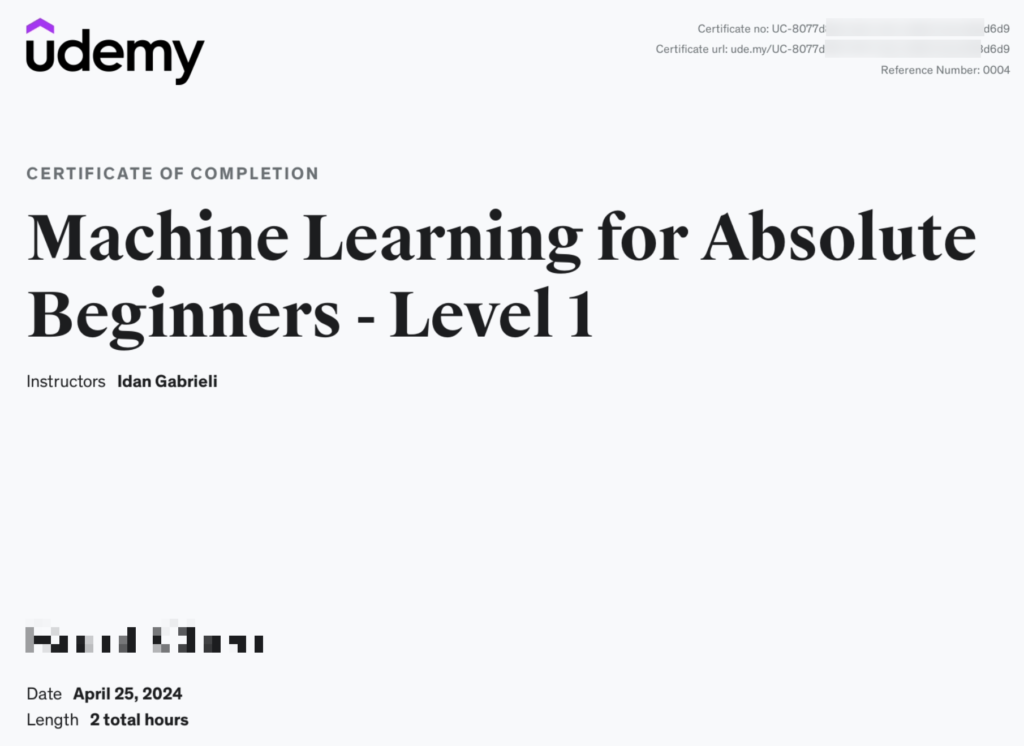
As you know I was in progress learning Andrew Ng's Supervised Machine Learning: Regression and Classification, it's so dry!
So I also spare some time to pick up some easy ML courses to help me to understand.
Today I came across Machine Learning for Absolute Beginners - Level 1 and it's really easy and friendly to beginner.
Finished in 2.5 hours - Maybe because I've made some good progress in Supervised Machine Learning: Regression and Classification and so feel it's easy.
I want to share my notes in this blog post.
Applied AI or Shallow AI
Industry’s robot can handle specific small task which has been programmed, it’s called Applied AI or Shallow AI.
Under-fitting and over-fitting are challenges for Generalization.
Under-fitting
The trained model is not working well on the training data and can’t generalize to new data.
Reasons may be:
- The model was too simple
- Data set is not good enough
An idea training process, it would looks like:
Under fitting….. better fitting…. Good fit
Over-fitting
The trained model is working well on the training data and can’t generalize well to new data.
Reasons may be:
- Training dataset is not a true distribution of the data (mitigation: use much larger training dataset, using a test dataset)
- Too complex model (fit the data as simple as possible)
- Small training dataset
Training dataset (labeled) -> ML Training phase -> Trained Model
The input (unlabeled dataset) -> processed by Trained model (inference phase) -> output (labeled dataset)
Approaches or learning algorithms of ML systems can be categorized into:
- Supervised Learning
- Unsupervised Learning
- Reinforcement Learning
Supervised Learning
There are two very typical tasks that are performed using supervised learning:
- classification (this is not clustering which belongs to Unsupervised learning!)
- One of the algorithm: Support Vector Machines (SVM)
- regression -> Statistical methods for estimating for strength of the relationship between a dependent variable and one or more independent variables.
- Learner regression
- Logistic regression
- Polynomial regression
Shallow Learning
One of the common classification algorithms under the shallow learning category is called Support Vector Machines (SVM).
Unsupervised Learning
The goal is to identify automatically meaningful patterns in unlabeled data.
- Clustering -> clustering is the task of identifying similar instances with shared attributes in a data set and group them together into clusters, grouping a set of objects in such a way that objects in the same group are more similar to each other than those in other groups.
The output of the algorithm will be a set of labels assigning each data point to one of the identified clusters.- Customer segmentation, like demographic information
- Anomaly/Outlier detection
- Dimension reduction - why we have this: one of the biggest challenges of supervised learning is that there are too many features as input.
- Large dataset -> pre-processing (Dimension Reduction) -> produce smaller dataset -> use the dataset for training Supervised learning model.
- Image segmentation
Semi-supervised Learning
Sitting between supervised learning and unsupervised learning
It works like this way:
Unlabeled dataset -> clustering -> clusters 1, 2, 3… -> Label the dataset -> Labeled dataset can be used for training a Supervised Learning.
Reinforcement Learning
Completely different with above (supervised and unsupervised).
It’s not using a group of labeled or unlabeled examples.
Used as a framework for decision-making tasks based on goals.
Perform a complex objective while performing multiple sequences of actions.
Usage
- Chess game (all computer games typically) to achieve superhuman performance
- The feedback on selected strategies is delayed!
- Try things and get feedback. In other words, based on the feedback or interaction, the model is learning.
- Training robot to perform tasks in dynamic environment or building real time recommendations
RL is a method being used to let machines learn know to behave based on interaction with the environment while focusing on some end goal.
Decision Making Agent (Under RL)
Because there are some end goals, so there must be a reward mechanism to move forward to the right direction while in the learning process.
RL builds a prediction model by gaining feedback from random trial and error and leveraging insight from previous interations.
The cumulative knowledge of how to achieve a specific goal is reinforced again and again by experience.
Comments on the course
This course was indeed designed for "Absolute Beginners".
One suggestion is that the quizzes are too easy, as most simply reiterate the content explained in the course without introducing any variations or ambiguities to challenge the learner.